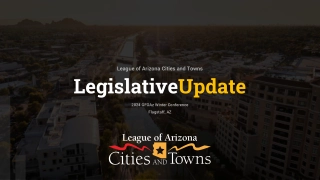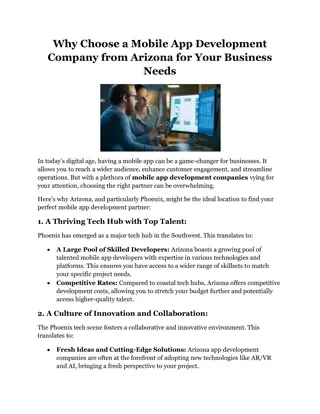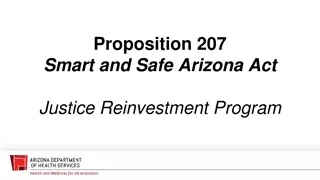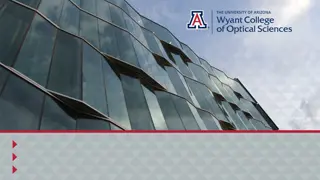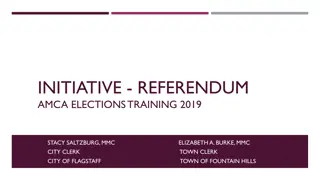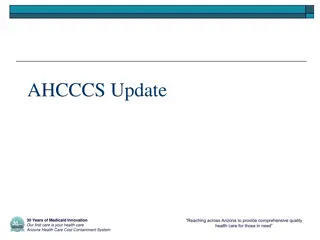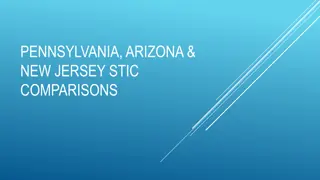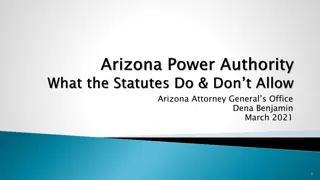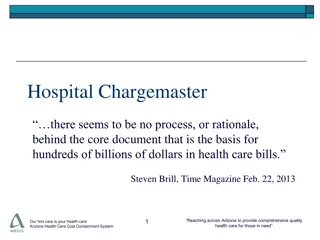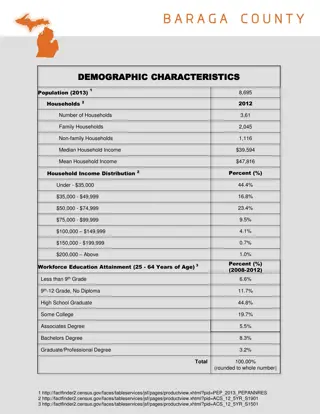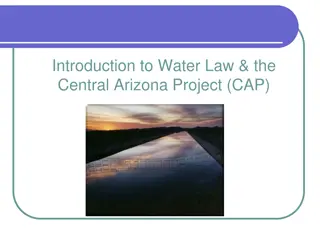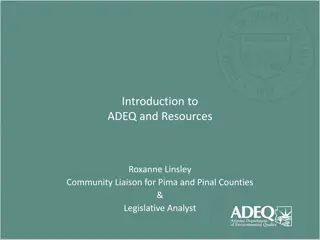The Government Structure in Arizona
The content outlines the structure of the Arizona government, focusing on the Executive and Judicial branches. It highlights the roles and responsibilities of key positions such as the Governor, Secretary of State, Attorney General, as well as details about the state courts and their functions. The information provides insights into how laws get interpreted, problem mediation, and accountability within the state's legal system.
Download Presentation

Please find below an Image/Link to download the presentation.
The content on the website is provided AS IS for your information and personal use only. It may not be sold, licensed, or shared on other websites without obtaining consent from the author. Download presentation by click this link. If you encounter any issues during the download, it is possible that the publisher has removed the file from their server.
E N D
Presentation Transcript
AZ Executive Branch
Governor Delivers budget proposal commander and chief of the national guard Call a special session Appoints judges Limits 2 terms Veto bills Can be impeached Can t change a citizen initiative AZ Executive Branch Plural Executive Secretary of state (Next in line to be governor) Attorney general State treasurer Superintendent of public instruction State mine inspector
AZ Judicial Branch
AZ Judicial Branch
Article 6 of the state constitution created the branch Made up of all the state courts Responsible to interpret state law Mediate problems between other branches Hold law breakers accountable AZ Judicial Branch
Article 6 of the state constitution created the branch Made up of all the state courts Responsible to interpret state law Mediate problems between other branches Hold law breakers accountable 1 level Justice courts Less serious No judges justice of the peace Trial court AZ Judicial Branch
Article 6 of the state constitution created the branch Made up of all the state courts Responsible to interpret state law Mediate problems between other branches Hold law breakers accountable 2 Level Superior courts 174 judges 4 year term Felony, civil cases Maricopa and Pima do selection 1 level Justice courts Less serious No judges justice of the peace Trial court AZ Judicial Branch
Article 6 of the state constitution created the branch Made up of all the state courts Responsible to interpret state law Mediate problems between other branches Hold law breakers accountable 2 Level Superior courts 174 judges 4 year term Felony, civil cases Maricopa and Pima do selection 1 level Justice courts Less serious No judges justice of the peace Trial court 3rd Court of appeals Judges are all appointed 22 court judges 6 terms AZ Judicial Branch
Article 6 of the state constitution created the branch Made up of all the state courts Responsible to interpret state law Mediate problems between other branches Hold law breakers accountable 2 Level Superior courts 174 judges 4 year term Felony, civil cases Maricopa and Pima do selection 1 level Justice courts Less serious No judges justice of the peace Trial court 3rd Court of appeals Judges are all appointed 22 court judges 6 terms AZ Judicial Branch 4th Supreme court Highest court State officers Determine if laws are constitutional 6 year term selection
Comparing State Legislature to Federal Legislature Double Bubble
Double bubble Federal Legislature AZ Legislature
Senate House of Rep. Veto Federal Legislature AZ Legislature 1st made Leg. Branch Laws start out the same
Senate 30 members in the senate 100 members in the senate House of Rep. 50 15 States Districts Veto Federal Legislature AZ Legislature Meet at the Capitol Washingto n D.C Meet at the Capitol (Phoenix) 1st made Leg. Branch Unlimited Terms 60 State 2yr. Term 8 year max Laws start out the same Representativ es population 435in the house
Local Government
County Special Districts Local City Governmen t
County 15 counties-libraries-made everyone have access to gov t-county sheriff- county superintendent- health- police-run the jails- provide fire for non city residence- state legislature tells the counties what to do Special Districts Local City Governmen t
County 15 counties-libraries-made everyone have access to gov t-county sheriff- county superintendent- health- police-run the jails- provide fire for non city residence- state legislature tells the counties what to do Special Districts 227 school districts Governing board that makes decisions Asks voters for overrides (money for districts) 10 community colleges Local City Governmen t
In chandler School district is #80 County 15 counties-libraries-made everyone have access to gov t-county sheriff- county superintendent- health- police-run the jails- provide fire for non city residence- state legislature tells the counties what to do Special Districts 227 school districts Governing board that makes decisions Asks voters for overrides (money for districts) 10 community colleges Local City Government 1500 population for a town 3000 population for a city Police, Fire, Garbage, roads, libraries There is a city council, manager and mayor.
Write paragraph summary to share what you learned about Arizona government.
22 Tribes Treaties with the national gov t from 1771-1777 to have their own gov t Each tribe has nationhood status, nations within a nation: meaning they have their own gov t, laws, protection Head of the tribe is governor, president, or chief Tribal council is governs and is elected by the tribes Navajo Nation is the largest nation in the USA Public schools located on tribal lands Tribes try to partner with state gov t Tribal Gov t
Write a summary about tribal government
AZ vs. Federal Govt How a bill becomes a law. Standards 3-3-1a,b,c
Learning goal: Compare how a bill becomes a law in AZ to how a federal bill is created. Activity: After watching Kids and the Capitol section: How a Bill Becomes a Law. Create a tree map to compare AZ to the Federal gov t. First create a tree map Use your notes to complete the nine steps it takes for a bill to become a law on the Federal gov t side.
Tree map How a bill becomes a law Federal Gov t AZ
Tree map How a bill becomes a law Federal Gov t AZ Idea Bill is proposed in the Senate or House Assigned to committee Debated and voted on Senate / House Sent to other house Senate/House Conference committee Sent back for final approval to the Senate/House Sent to the President President can veto, sign, do nothing (pocket veto) If the Pres. Veto the Senate and House can override with 2/3 vote
Tree map AZ Idea Legislative council writes it into a bill Goes into the hopper in House/Senate Pres. of the Senate or Speaker of the house assigns a # (1000 for House 2000 for Senate) First reading-Introduced on Floor Sent to committee, second reading and if it passes committee Then it is sent to committee of rules to insure it is constitutional Next it goes to caucus then to C.O.W. (amendments can still be added) Third reading no changes are allowed. Formal vote occurs. *Becomes an engrossed bill and sent to the other house for approval Next it is sent to the conference committee to choose one version of the bill There is a final vote from each house after the version is decided Finally it is Sent the governor: She has 5 days to sign it (10 days if they are not in session) Veto it the House and Senate can pass with a 2/3 vote Not sign it and then it becomes law
Tree map How a Bill Becomes a Law Federal Gov t AZ Idea Idea Bill is proposed in the Senate or House Legislative council writes it into a bill Goes into the hopper in House/Senate Pres. of the Senate or Speaker of the house assigns a # (1000 for House 2000 for Senate) First reading-Introduced on Floor Sent to committee, second reading and if it passes committee Then it is sent to committee of rules to insure it is constitutional Next it goes to caucus then to C.O.W. (amendments can still be added) Third reading no changes are allowed. Formal vote occurs. *Becomes an engrossed bill and sent to the other house for approval Next it is sent to the conference committee to choose one version of the bill There is a final vote from each house after the version is decided Finally it is Sent the governor: She has 5 days to sign it (10 days if they are not in session) Veto it the House and Senate can pass with a 2/3 vote Not sign it and then it becomes law Assigned to committee Debated and voted on Senate / House Sent to other house Senate/House Conference committee Sent back for final approval to the Senate/House Sent to the President President can veto, sign, do nothing (pocket veto) If the Pres. Veto the Senate and House can override with 2/3 vote
Laws If you could make a law about anything, what would it be and why?
How A Bill Becomes A Law Class Discussion What is a law? What are some laws? Why do we have these laws? Why do we have laws? How does a law start? How does it go from an idea to a law?
What house of Congress does a bill start in? Laws may be initiated in either chamber of Congress, the House of Representatives or the Senate. For this example, we will track a bill introduced in the House of Representatives.
1. When a Representative has an idea for a new law (or an idea is brought to them by a citizen), s/he becomes the sponsor of that bill and introduces it. The clerk assigns a legislative number to the bill H.R. for bills introduced in the House of Representatives S. for bills introduced in the Senate.
2. Next, the bill is assigned to a committee (the House has 22 standing committees, each with jurisdiction over bills in certain areas) by the Speaker of the House so that it can be studied.
3. If the bill is released, it then goes on a calendar (a list of bills awaiting action).
4. The bill now goes to the floor of the House for consideration and begins with a complete reading of the bill (sometimes this is the only complete reading). If the bill passes by simple majority (218 of 435), the bill moves to the Senate.
5. In order to be introduced in the Senate, a senator must be recognized as the presiding officer and announce the introduction of the bill.
5. In order to be introduced in the Senate, a senator must be recognized as the presiding officer and announce the introduction of the bill. Sometimes, when a bill has passed in one house, it becomes known as an act; however, this term usually means a bill that has been passed by both houses and becomes law.
6. Just as in the House, the bill then is assigned to a committee. It is assigned to one of the Senate's 16 standing committees by the presiding officer. The Senate committee studies and either releases or tables the bill just like the House standing committee.
7. Once released, the bill goes to the Senate floor for consideration. Bills are voted on in the Senate based on the order they come from the committee; however, an urgent bill may be pushed ahead by leaders of the majority party. A simple majority (51 of 100) passes the bill.
8. The bill now moves onto a conference committee, which is made up of members from each House. The committee works out any differences between the House and Senate versions of the bill. The revised bill is sent back to both houses for their final approval.
9. The enrolled bill is now signed by the Speaker of the House and then the vice president. Finally, it is sent for presidential consideration. The president has ten days to sign or veto the enrolled bill. If the president vetoes the bill, it can still become a law if two-thirds of the Senate and two-thirds of the House then vote in favor of the bill.
Assignment part one- Using a campaign character, you will be writing a story about a bill becoming a law. You need to come up with an original idea for a bill (make sure you title it- H.R.___ or S.___), a main character, and include the 9 steps of a bill becoming a law. It should have an introduction (which includes the initial idea), a sentence /paragraph for each step, and a conclusion. That is a total of 11 sentence/paragraphs. Example! Step 1- Go through the 9 steps in your notes and write a one sentence summary of the step involving your character.
Scary Gary Introduction- A citizen has an idea for a new law that would require each city to have a clown that dances in your driveway each morning. Step #1- The citizen sends a letter to Rep. Scary Gary and he decides it is something that he wants to sponsor. He then writes it into a bill which is titled HR 345. Step #2- The bill is then sent to the Circus Committee for discussion and revision. Step #3- After it is released it goes on the calendar in order to be voted on later. Step #4- Scary Gary then reads it to the House of Reps. And is voted on, it passes with a majority vote. Step #5- Scary Gary passes it off to his old Senator pal Crazy Carl to be introduced in the Senate. Step #6- Crazy Carl then takes it to the Senate and it is assigned to the Juggling Committee to be discussed and revised. Step #7- After it is released it is sent to the Senate floor for consideration, it is voted on and passed with a majority vote. Step #8- The bill now moves on to a conference committee to iron out any differences between the House version and the Senate version. They write up the final version of the bill. Step #9- The bill is now signed by the Speaker of the House and the Vice President. Conclusion- It is sent to the President and is signed into law, Scary Gary and Crazy Carl then throw a clown party for the whole town.
Assignment Part 2-cartoon Your story should be finished before you start the cartoon. Using your story you will draw a cartoon with each step illustrated in a box (number each step). It should be in full color and detail with a brief caption beneath explaining each frame.
Story template Introduction- Step #1- Step #2- Step #3- Step #4- Step #5- Step #6- Step #7- Step #8- Step #9- Conclusion-
Cartoon Name: Class:













